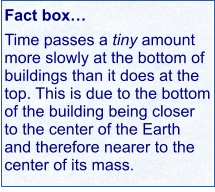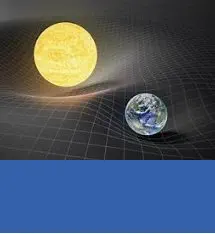
SuperFast Guide to General Relativity


Quick and easy summaries of relativity and related subjects
General Relativity, also known as the General Theory of Relativity, is the theory of
gravitation published by Albert Einstein in 1915. It is the current description of gravity in
modern physics, one of the fundamental forces in the universe.
Energy from nuclear fusion - From stars to black holes
Isn’t it just a theory? - The word theory has a different meaning in science

General Relativity refines Newton’s Law of Universal Gravitation, providing a unified
description of gravity as a property of space and time, called four-dimensional
spacetime. In particular, the curvature of spacetime is directly related to the energy
and momentum of whatever matter and radiation are present.
The relation is specified by the Einstein field equations. These are complex, requiring
much computation, and the effects are only significant at very high masses (such as
found near stars, for example). For this reason the paths of space probes are still
usually calculated using Newtonian gravitation. Any difference in the calculated results
of the two systems will almost always be so small as to be negligible.
Some predictions of General Relativity, however, are beyond Newton’s Law of
Universal Gravitation in classical physics. Examples include:
The passage of time: Time slows down near large masses. The larger the mass
the more time slows down.
The geometry of space, meaning light can bend around large masses such as
stars. A phenomena known as gravitational lensing.
Black holes: Regions of space from which even light cannot escape.

All tests of General Relativity have so far been shown to be in agreement with the
theory and have provided the modern framework for the history of the universe and
cosmology, thus leading to the discovery of the Big Bang. Despite the introduction of a
number of alternative theories, General Relativity is generally accepted by scientists to
be the simplest theory consistent with experimental data.
However, combining General Relativity with the laws of quantum physics remains a
problem and it is not yet known how gravity can be unified with the three non-
gravitational forces: strong, weak, and electromagnetic.
In summary: General Relativity is Albert Einstein’s theory of gravity, published in 1915,
which describes gravity as a curvature of space and time caused by mass and energy.
It predicts phenomena like gravitational time dilation and the existence of black holes.
Suggested further reading:
Advertisement

SuperFast Guide to
General Relativity
[ Special Relativity ] [ General Relativity ] [ Einstein ] [ Time Dilation ]
[ Black Holes ] [ Twin Paradox ] [ Time Dilation Formula ]
[ Special Relativity ] [ General Relativity ] [ Einstein ] [ Time Dilation ]
[ Black Holes ] [ Twin Paradox ] [ Time Dilation Formula ]
Advertisement

Quick and easy summaries of relativity and related subjects
SuperFast Guide to General Relativity
General Relativity, also known as the General Theory of
Relativity, is the theory of gravitation published by Albert Einstein
in 1915. It is the current description of gravity in modern physics,
one of the fundamental forces in the universe.
General Relativity refines Newton’s Law of Universal Gravitation,
providing a unified description of gravity as a property of space
and time, called four-dimensional spacetime. In particular, the
curvature of spacetime is directly related to the energy and
momentum of whatever matter and radiation are present.
The relation is specified by the Einstein field equations. These
are complex, requiring much computation, and the effects are
only significant at very high masses (such as found near stars, for
example). For this reason the paths of space probes are still
usually calculated using Newtonian gravitation. Any difference in
the calculated results of the two systems will almost always be so
small as to be negligible.
Some predictions of General Relativity, however, are beyond
Newton’s Law of Universal Gravitation in classical physics.
Examples include:
The passage of time: Time slows down near large masses.
The larger the mass the more time slows down.
The geometry of space, meaning light can bend around large
masses such as stars. A phenomena known as gravitational
lensing.
Black holes: Regions of space from which even light cannot
escape.



All tests of General Relativity have so far been shown to be in
agreement with the theory and have provided the modern
framework for the history of the Universe and cosmology, thus
leading to the discovery of the Big Bang. Despite the introduction
of a number of alternative theories, General Relativity is
generally accepted by scientists to be the simplest theory
consistent with experimental data.
However, combining General Relativity with the laws of quantum
physics remains a problem and it is not yet known how gravity
can be unified with the three non-gravitational forces: strong,
weak, and electromagnetic.
In summary: General Relativity is Albert Einstein’s theory of
gravity, published in 1915, which describes gravity as a curvature
of space and time caused by mass and energy. It predicts
phenomena like gravitational time dilation and the existence of
black holes.
Suggested further reading:


Energy from nuclear fusion - From stars to black holes
Isn’t it just a theory? - The word theory has a different
meaning in science

[ Special Relativity ] [ General Relativity ] [ Einstein ]
[ Time Dilation ] [ Black Holes ] [ Twin Paradox ]

[ Special Relativity ] [ General Relativity ] [ Einstein ]
[ Time Dilation ] [ Black Holes ] [ Twin Paradox ]









